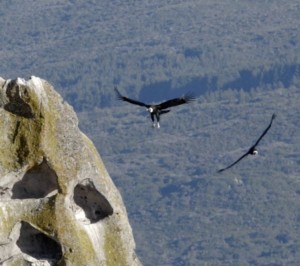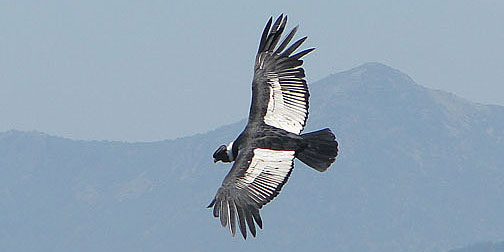LINKED PAPER
Comparison of lead contamination among related scavenging birds sharing food sources: a call for caution when using surrogate species. Plaza, P.I., Wiemeyer, G. & Lambertucci, S.A. 2020. IBIS. DOI: 10.1111/ibi.12815. VIEW
Surrogate species have been used for years as conservation tools worldwide. In fact, these species have been widely used to assess the effects of different anthropogenic disturbances, such as pollution, climate change or changes in land use on the ecosystem (Caro & O’doherty 1999). Particularly, surrogate species have been widely used to measure characteristics that are difficult or expensive to measure for the environment or other species (Landres 1992). However, for their effective use it is necessary to understand how good a surrogate species is for its environment or sympatric species (Favreau et al. 2006).
Lead contamination is a global problem affecting a great variety of bird species that can produces population declines and biodiversity loss (Haig et al. 2014). Today, the main source of lead affecting bird populations worldwide is the ingestion of ammunition produced by hunting activities (Fisher et al. 2006). In fact, this common and severe problem is threatening most scavenging birds around the world (Plaza & Lambertucci 2019). There are several studies on lead contamination using diverse bird species as surrogates to infer the potential impact of this threat on the environment and especially for threatened species. However, there is no clear information to demonstrate whether those species accurately predict the true impact of this threat.
In our study, we compared lead contamination between the threatened Andean Condor Vultur gryphus and the abundant American Black Vulture Coragyps atratus from North-Western Patagonia. To do this, we trapped condors and vultures and determined lead blood concentrations in each individual. In this geographical area, lead contamination associated with ammunition is an important environmental problem affecting Andean Condors, the most emblematic species from South America. However, less information is available about other scavenging birds such as the abundant Black Vulture, a closely related species with Andean condor. In North-Western Patagonia, Black Vultures share food sources with Andean condors (carcasses of cows, sheep, deer and hares) but also they incorporate anthropogenic food subsidies in their diet such as remnants of fisheries, slaughterhouses and even organic waste (Ballejo et al. 2018). Given Black Vultures show high abundances, are easy to capture, and have similar diet to condors, they might be considered a potential interesting surrogate species to infer lead contamination in the environment and to infer this threat in Andean Condors. However, the results of our study suggest that this was not the case, at least for our study area.

Figure 1 Andean Condors roosting in the Patagonian Steppe © Pablo Plaza
While this toxic metal affects both species, Andean Condors are more affected than Black Vultures. We found significantly higher lead blood concentrations in Andean Condors than in Black Vultures. In addition, the prevalence of lead levels over the threshold (20 ug/dL) was higher for condors than for Black Vultures. This suggests that using the latter as surrogate for the former may underestimate environmental lead and exposure of condors to lead.

Figure 2 Black Vultures roosting in an island close to Villa La Angostura city © Pablo Plaza
The disparity in lead contamination between species could reflect differences in their feeding ecology, but also different susceptibilities to this toxic metal associated with internal physiological factors. In the study area, Andean Condors feed mainly on large carcasses of wild pigs, sheep, red deer, and cows. In addition, they include a large proportion of Lagomorphs in their diet. These species are the most hunted in Patagonia and there are no regulations on the use of lead ammunition. Therefore, according to earlier work at the same site (Lambertucci et al. 2011) it is reasonable to assume that Andean Condors are exposed to carcasses from hunting activities that are contaminated with bullet fragments. While Black Vultures share food sources with condors, they may be less exposed to lead contamination perhaps as a consequence of the inclusion of some additional anthropogenic items in their diets, such as organic waste or meat discarded from slaughterhouses (Ballejo & de Santis 2013), which are free of ammunition fragments. The differences in lead contamination between species could be also associated to interspecies susceptibility to this toxin, related to differences in absorption/excretion rates, which could influence the lead concentrations reached in blood.
Our results highlight that a potential surrogate species may not always be as good a surrogate as presumed, particularly for lead exposure and contamination. Thus, it is key to first assess the suitability of one species as a surrogate for another to avoid drawing incorrect conclusions that may affect any number of species, especially endangered ones.
References
Ballejo, F. & de Santis, L.J. 2013. Dieta estacional del Jote Cabeza Negra (Coragyps atratus) en un área rural y una urbana en el noroeste patagónico. El Hornero 28: 07–14. VIEW
Ballejo, F., Lambertucci, S.A., Trejo, A. & De Santis, L.J. 2017. Trophic niche overlap among scavengers in Patagonia supports the condor-vulture competition hypothesis. Bird Conserv. Int. 28: 390-402. VIEW
Caro, T.M. & O’doherty, G. 1999. On the use of surrogate species in conservation biology. Conserv. Biol. 13: 805–814. VIEW
Favreau, J.M., Drew, C.A., Hess, G.R., Rubino, M.J., Koch, F.H. & Eschelbach, K.A. 2006. Recommendations for assessing the effectiveness of surrogate species approaches. Biodivers. Conserv. 15: 3949–3969. VIEW
Fisher, I.J., Pain, D.J. & Thomas, V.G. 2006. A review of lead poisoning from ammunition sources in terrestrial birds. Biol. Conserv. 131: 421–432. VIEW
Haig, S.M., D’Elia, J., Eagles-Smith, C., Fair, J.M., Gervais, J., Herring, G., Rivers, J.W. & Schulz, J.H. 2014. The persistent problem of lead poisoning in birds from ammunition and fishing tackle. The Condor 116: 408–428. VIEW
Lambertucci, S.A., Donázar, J.A., Huertas, A.D., Jiménez, B., Sáez, M., Sanchez-Zapata, J.A. & Hiraldo, F. 2011. Widening the problem of lead poisoning to a South-American top scavenger: Lead concentrations in feathers of wild Andean condors. Biol. Conserv. 144: 1464–1471. VIEW
Landres, P.B. 1992. Ecological indicators: panacea or liability. In: McKenzie, D.H., Hyatt, D.E., McDonald, V.I. (Eds.) Ecological Indicators. Vol. 2 (pp. 1295-1318). Elsevier Applied Scientific Publishers, Amsterdam. VIEW
Plaza, P.I. & Lambertucci, S.A. 2018. What do we know about lead contamination in wild vultures and condors? A review of decades of research. Sci. Total Environ. 654: 409-417. VIEW
Image credit
Featured image: Andean Condor Vultur gryphus | Dick Culbert | CC BY 2.0







